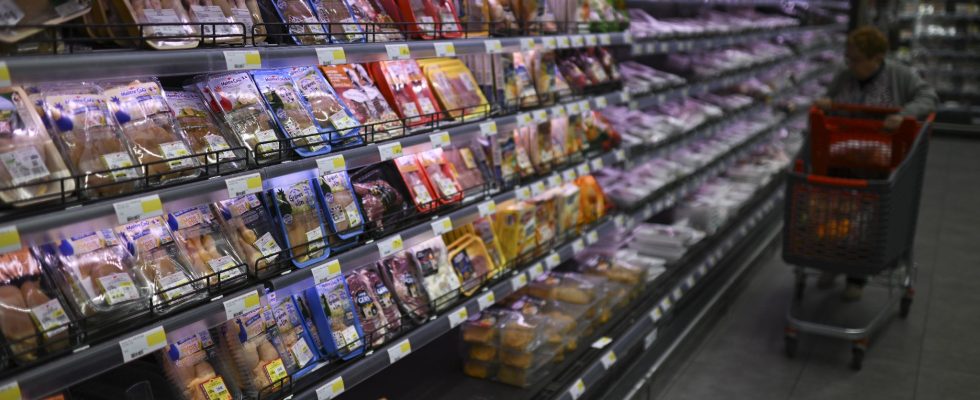During the summer, the problem was swept under the rug for a while. At the end of July, some good news even brought hope: INSEE announced that the rise in food prices was slowing down, to 12.6% year-on-year that month, after + 13.7% in June. But as the school year approached, the return to reality was brutal. Added to food inflation, still very high in August, was the explosion in the price of school supplies (+8.5% over one year).
A sign of a situation that has become critical, it was at 1 p.m. on TF1 last Sunday, the day before students returned to classes, that the president of Restos du Cœur, Patrice Douret, came to launch an appeal for donations to save the association, overwhelmed by the arrival of new beneficiaries, themselves squeezed by the rise in prices on the shelves. A salutary appeal, highly publicized and relayed, which quickly triggered several pledges of donations, including that of 10 million euros from the Arnault family and that of the players of the French football team.
But in reality, which households are most affected by food inflation? “Today it weighs the most on the most modest,” says, unsurprisingly, Sébastien Faivre, head of the consumer prices division at INSEE. More precisely, this corresponds to the first two deciles, or the least wealthy 20%. “There are several reasons for this: first of all, the weight of food in their expenditure is greater than for all households. Then, among the products that have increased, most are basic necessities such as bread, oils, rice and milk,” continues the expert. A third factor comes into play: “We have suffered even more marked increases on entry-level products, for which companies have less initial margin than on branded products in order to absorb the rise in world prices”.
Declining volumes
Consequence: these populations are forced to make trade-offs. “They tend to focus on cheaper products, but of lower quality. We find the reflexes of junk food, we also see it in the statistics showing the regression of organic”, underlines Florence Jany-Catrice, professor in economics at the University of Lille. For several months now, some households have been reducing their consumption, due to being unable to fill their baskets. “There is a real subject of purchasing power. This translates into a fairly significant drop in volumes sold, especially international brands”, illustrates Jacques Creyssel, general manager of the Federation of Commerce and Distribution.
A phenomenon which could turn against manufacturers and distributors in the future, and force them to review their practices. “If consumers reduce their purchases in supermarkets and hypermarkets, knowing that their model is based on mass consumption, that will be a problem. As many manufacturers have rebuilt their margins, if you no longer have customers, it prices will have to be lowered,” said Anne-Sophie Alsif, chief economist of the BDO consulting firm.
Middle classes more attentive to prices
At Secours populaire, the profile of beneficiaries has also evolved. “We are seeing more and more people who have a job and who receive the equivalent of the minimum wage. We are not used to seeing this audience,” notes Houria Tareb, national secretary of the association. Among the middle classes too, food inflation is strongly felt, but they have more room for maneuver than the less well-off.
“They have a dual strategy, which is to back off on products that are not completely necessary and secondly, they are more attentive to prices”, analyzes Florence Jany-Catrice. According to her, “this has an impact on the feeling of being downgraded. We are avoiding a certain number of products that we could previously access without having to think, to please the children, from excess consumption.” The richest households, for their part, do not suffer from food inflation. “This has not no consequences for them because they are insensitive to prices,” says the economics professor.
Double penalty for residents on the outskirts
The territory also plays a major role. The less well-off French people who live on the outskirts of cities have already had to bear rising fuel prices for several months in order to get around and get to work. “They also have less access to the short circuit and are forced to go to shopping centers, where they buy industrial products that are most affected by inflation,” explains Anne-Sophie Alsif of BDO. This is the case around Toulouse, in Haute-Garonne. “Some moved away from the city because the rents were too expensive, thinking that they would have a better quality of life. The increase in fuel and food prices put them in difficulty”, says Houria Tareb of Popular Relief.
In the opinion of experts, the situation is unlikely to return to pre-Ukrainian conflict levels. “We rather have the impression that the high price level is settling in for a long time. For oil, we can have inflationary peaks like in 2008 with the war in Georgia. Prices then fell. For food, we don’t sees no significant drop, only adjustments which are not revealing”, points out Sébastien Faivre of INSEE. Enough to widen inequalities even further.
